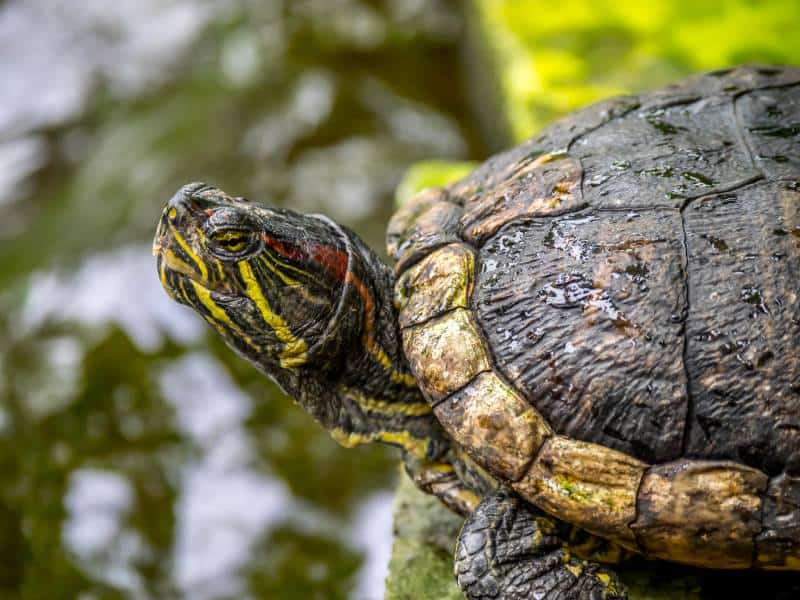Some of the most exciting animals found in Indiana are turtles. Turtles have been around for more than 210 million years, and they come in all shapes and sizes. Turtles are great pets to bring into your home because they can be taught tricks, have a long lifespan, don’t require much room, and they’re adorable! Turtles also make great companions for children with autism or people who suffer from depression. This blog post will go over seven excellent types of turtles that you might find living in Indiana!

The 7 Turtles Found in Indiana
1. Alligator Snapping Turtle
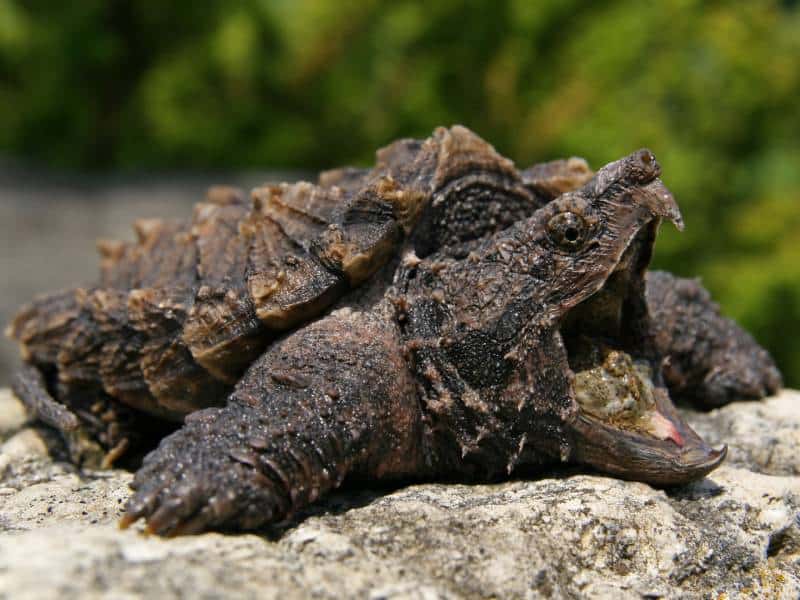
| Species: | Macrochelys temminckii |
| Longevity: | 80 – 120 years |
| Good to own as a pet?: | Yes |
| Legal to own?: | Yes |
| Adult size: | 13 – 24 inches |
| Diet: | Omnivorous |
The Alligator Snapping Turtle is often considered the largest freshwater hard-shelled turtle in North America. They can grow to be more than 2 feet long and weigh up to 90 pounds! Alligator snapping turtles have a slower metabolism, meaning they spend most of their time buried in mud on river bottoms or soaking at the bottom of deep lakes. They enjoy basking in the sun, and on warm, winter days, they can often be found out of the water to soak up some rays.
The Alligator Snapping Turtle’s natural habitat is in the southern United States, from Washington to Louisiana. They live near rivers and lakes with soft bottoms that they can burrow into if necessary. Turtles are generally solitary animals, but this species will sometimes congregate at night to bask or feed on vegetation like lily pads or cattails along the shore.
Its carapace is olive-brown, and in males, it tends to have a yellowish plastron with black markings near the head. The skin on an alligator snapping turtle can be either brown or gray. They are giant turtles that can weigh up to 90 pounds! Their claws are what they use to hunt and eat their prey.
Alligator Snapping Turtles are carnivores that primarily feed on aquatic plants, fish, amphibians, and other invertebrates. They will also occasionally eat some small mammals such as muskrats or nutria rats! Turtles in the wild can live more than 50 years, but Alligator Snapping Turtles have a much shorter lifespan.
2. Blanding’s Turtle
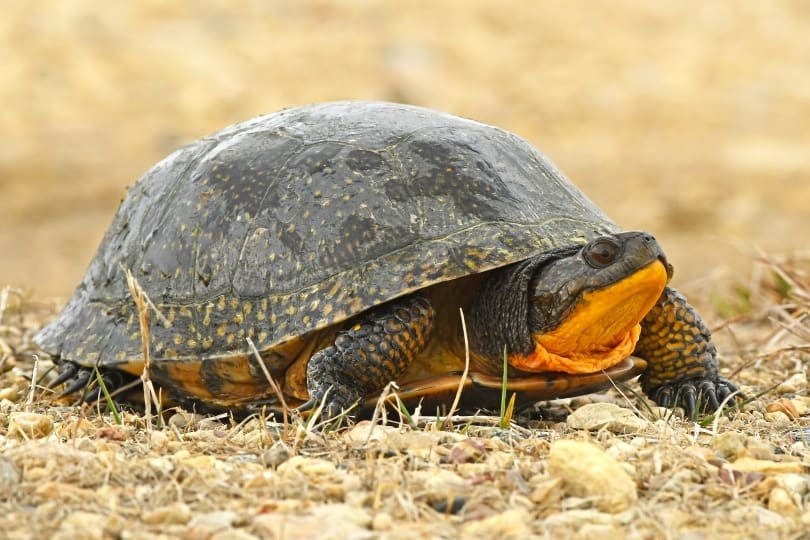
| Species: | Emydoidea blandingii |
| Longevity: | 80 – 90 years |
| Good to own as a pet?: | Yes |
| Legal to own?: | Yes |
| Adult size: | 10 inches |
| Diet: | Omnivorous |
The Blanding’s Turtle is a relatively small species of turtle that lives in the eastern United States. Their carapace ranges from yellow to brown, and they have dark spots on their back, tail, neck, legs, and head. The Blanding’s turtle has a lighter underside with four toes on its front feet and five toes on its hind feet.
The Blanding’s Turtle lives in the eastern United States, from Minnesota to Illinois and south to Louisiana. They prefer living near ponds with soft bottoms or a shoreline with plenty of vegetation for them to feed on. Turtles are usually solitary animals, but they will sometimes congregate at night when food sources are not plentiful or during mating season in late spring. The average lifespan in captivity for a Blanding turtle is about 20 years.
The Blanding’s Turtle is a small turtle species with a yellow to brown carapace with dark spots on the back, tail, neck, legs, and head! Turtles have four toes on their front feet and five toes on their hind feet, which they use as a prop when walking. Turtles are cold-blooded animals, so their shell can help them regulate their body temperature!
3. Eastern Box Turtle
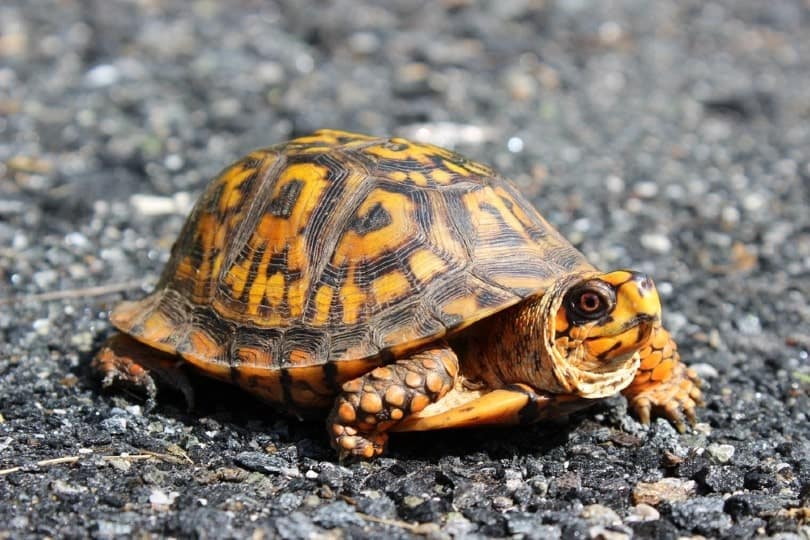
| Species: | Terrapene carolina |
| Longevity: | 40 – 50 years |
| Good to own as a pet?: | Yes |
| Legal to own?: | Yes |
| Adult size: | 4 – 7 inches |
| Diet: | Omnivorous |
This box turtle is found in the Ohio River Valley. They are primarily aquatic but can be seen on land during droughts, rainstorms, or hurricanes. The Eastern Box Turtles head has a distinctive pattern of concentric rings with yellow lines that run down from each eye to their nose and up to their neck collar. During the summer, they are a brownish color with light yellow stripes and spots. In winter, their skin is more of dark olive green. The Eastern Box turtle shell is wide on top but pronouncedly indented in its center to form two plates that fit together like pieces of an eight-sided puzzle.
Eastern Box Turtles are typically tan or brown, but they can vary in color depending on the country’s area. It is typical for the eastern box turtle to have yellow stripes or green markings in some populations. Turtles cannot regulate their body temperature like other animals, so they rely on camouflage and seasonal changes to keep them cool.
These turtles are omnivorous and will eat anything they can find, but their diet typically consists of insects, slugs, worms, grubs, frogs, lizards, and birds. Turtles cannot chew because they don’t have teeth, so the food must be cut into small pieces to swallow whole.
4. Eastern Mud Turtle
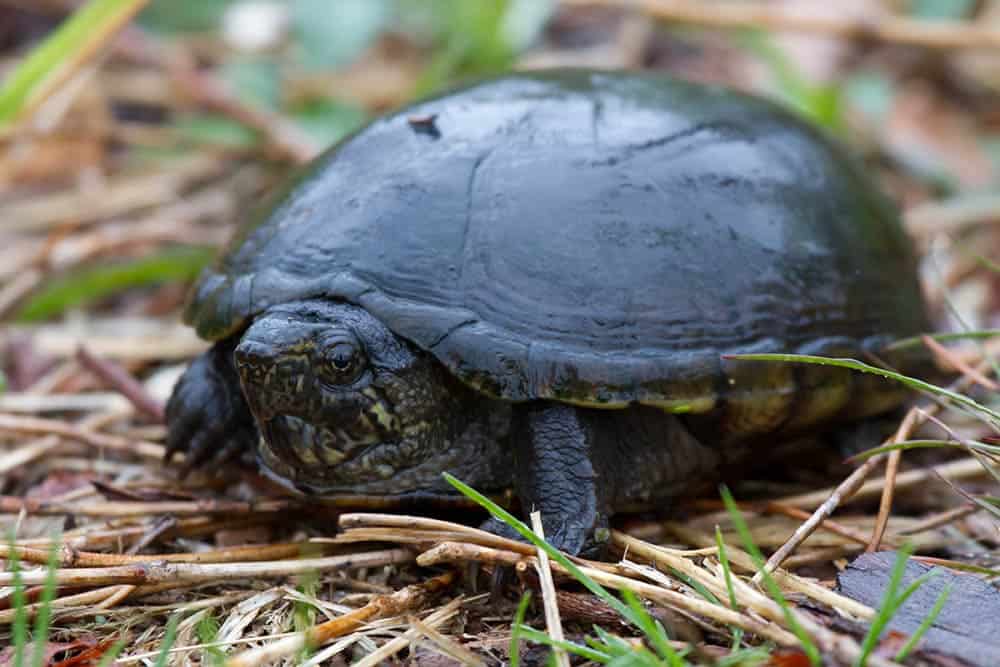
| Species: | Kinosternon subrubrum |
| Longevity: | 20 – 30 years |
| Good to own as a pet?: | Yes |
| Legal to own?: | Yes |
| Adult size: | 3 – 4 inches |
| Diet: | Omnivorous |
The Eastern Mud Turtle is a small aquatic turtle. It can be found in the eastern United States, from southeastern Indiana to northern Florida and westward into West Virginia. The Eastern Mud Turtle’s range is limited by winter temperatures that are too cold for their short-term survival. In Indiana, mud turtles are found near water sources like lakes, marshes, and small ponds.
These turtles have brown, gray, or black shells with yellow markings.
5. Eastern Musk Turtle

| Species: | Sternotherus odoratus |
| Longevity: | 40 – 60 years |
| Good to own as a pet?: | Yes |
| Legal to own?: | Yes |
| Adult size: | 5 – 10 inches |
| Diet: | Carnivorous |
The Eastern Musk Turtle is the only species in Indiana that has a pointed nose. It can be found throughout the southern and central United States. However, it does not get huge (most adults are less than six inches). The pointy part of their noses helps them breathe while underwater and find food on land. Because they don’t have scales on their undersides, they must come out of the water to sunbathe.
These turtles are found in a variety of different habitats, including streams, marshes, and ponds. The Eastern Musk Turtle can have various colors such as black, brown, greenish-brown, and olive. They also may or may not have stripes on their head (most do).
These turtles prefer to eat insects, fish, and small amphibians. The adults will sometimes feed in the water while juveniles stay on land and burrow in the mud for their food.
6. False Map Turtle
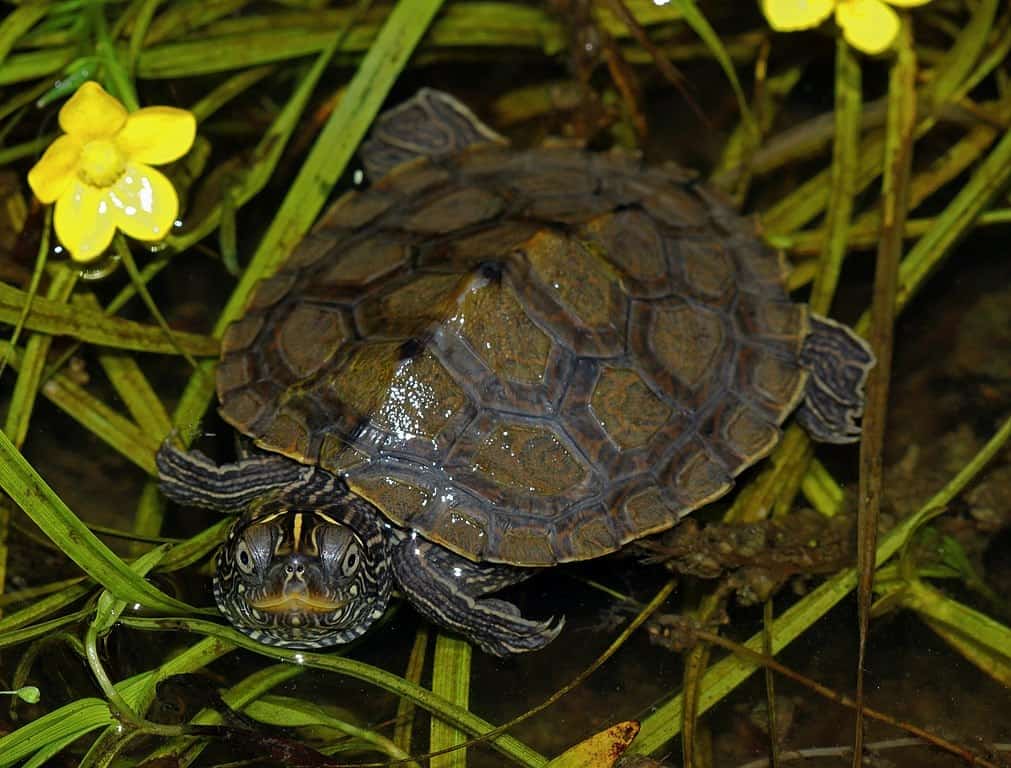
| Species: | Graptemys pseudogeographica |
| Longevity: | 30 – 40 years |
| Good to own as a pet?: | Yes |
| Legal to own?: | Yes |
| Adult size: | 4 – 10 inches |
| Diet: | Carnivorous |
False Map Turtles are usually found in various water habitats, including ponds, streams, and rivers. They have been known to live in freshwater, brackish water, and saltwater. Those that live near the coast tend to stay on or very close to the shorelines meaning they can be exposed quite easily during high tide periods where there is often more risk of predators coming into contact with these reptiles.
False Map Turtles can live in various water habitats, including freshwater, brackish water, and saltwater. Turtles that live near the coast often stay on or close to shorelines where they are exposed more easily during high tide periods where there is an increased risk for predators coming into contact with these reptiles.
These turtles are brown to black with two lighter colored stripes on their head. They have dark blotches and spots that can be seen all over the skin, along with a golden ring around their eyes.
False map turtles are omnivores, and they will eat both plants and animals.
7. Northern Map Turtle

| Species: | G. geographica |
| Longevity: | 30 – 50 years |
| Good to own as a pet?: | Yes |
| Legal to own?: | Yes |
| Adult size: | 4 – 10 inches |
| Diet: | Omnivorous |
This softshell turtle lives in the eastern United States with a lifespan of up to 50 years. They are known for their distinctive pattern on their shell, which usually has dark brown or black markings over a yellow background with some lighter spots around its head.
The Northern Map Turtle is found in various habitats, but primarily live in water and spend their entire lives underwater. They are found in ponds, lakes, rivers, swamps, and marshes with sand or mud bottoms.
The Northern Map Turtle is characterized by its three rows of dorsal scutes or scales on the top shell. The belly and carapace are yellow with black dots, while the plastron, or bottom half of the body, is usually orange-tan. One distinguishing feature about this species is the concave margin of the scutes on its carapace.
Turtles found in Indiana are omnivores. They will eat small insects, other aquatic animals, berries, and fruit. They also like to forage on land at night or during the day when they can escape from predators; this may include eating spiders – not your average turtle food!

Is It Illegal to Keep a Painted Turtle in Indiana?
In Indiana, it is illegal to take a live turtle or its eggs from the wild. Turtles are protected by state law and cannot be removed from nature without an appropriate permit. According to the Department of Natural Resources, painted turtles (both adult and juveniles) typically spend their entire lives in water bodies they were born in with little migration out of that range. Turtles are very vulnerable to cars and predators, so they must stay in the areas where they were born.

Where Can I Find Turtles in Indiana?
These turtles can be found in a variety of habitats, from aquatic to terrestrial ecosystems. Turtles that live near the water do not have long legs, and they will often use their front flippers for swimming, but those turtles that stay on land are sometimes capable swimmers. Turtles typically prefer slow-moving bodies of water like lakes or ponds because it is easier for them to camouflage themselves from predators. Turtles that live on land depend on the weather and temperature because they cannot regulate their body heat as other animals can.

Conclusion
Indiana is home to many types of turtles, some more common than others. Hopefully, this article has helped you learn about and identify the seven most incredible (and endangered) turtles found in our state! Please share it with your friends so we can help protect these beautiful creatures for generations to come. If you need professional guidance on keeping a turtle as a pet, please contact us anytime!
Related Read:
Featured Image Credit: Tony Moran, Shutterstock
